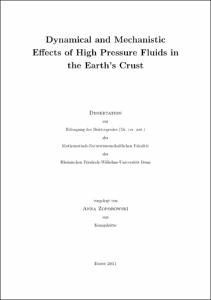Zoporowski, Anna: Dynamical and Mechanistic Effects of High Pressure Fluids in the Earth's Crust. - Bonn, 2012. - Dissertation, Rheinische Friedrich-Wilhelms-Universität Bonn.
Online-Ausgabe in bonndoc: https://nbn-resolving.org/urn:nbn:de:hbz:5n-27923
Online-Ausgabe in bonndoc: https://nbn-resolving.org/urn:nbn:de:hbz:5n-27923
@phdthesis{handle:20.500.11811/5284,
urn: https://nbn-resolving.org/urn:nbn:de:hbz:5n-27923,
author = {{Anna Zoporowski}},
title = {Dynamical and Mechanistic Effects of High Pressure Fluids in the Earth's Crust},
school = {Rheinische Friedrich-Wilhelms-Universität Bonn},
year = 2012,
month = mar,
note = {Overpressurized fluids in the lithosphere play a significant role in a diverse range of globally observed natural hazards. Their occurrence during volcanic eruptions or earth degassing processes is apparent, but their influence on seismic processes is still underestimated. The projects examined in this thesis aim to advance the physical understanding of fluid pressure related geo-hazards, and their effects on hydro-mechanical and dynamical systems. The cases discussed here cover many areas of geophysical research, analyzes of aftershock triggering scenarios, modeling dynamical behavior of fluid flow in volcanic systems, and developing schemes for understanding earthquake-fluid pressure correlations.
A numerical model, developed for the Indonesian LUSI mud volcano, provides a dynamical description of mud volcano eruptions. Influence of rheological effects and fluid properties on extrusion rate, cyclic behavior and long-term decay are investigated. The conceptual model is stable to parameter changes, being adapted for and transferable to various mudflow issues.
We investigate the involvement of overpressurized fluids in earthquake generation with spatiotemporal investigations on the 2009 L'Aquila aftershock sequence in Italy. Analyses of the generally accepted triggering mechanism of static stress transfer shows that a pure mechanistic process is not responsible for the seismic events. An investigation of the volumetric strain response suggests high-pressure fluid induced seismicity, a result consistent with high pore pressures at depth inferred from earthquake focal mechanisms of that event.
Coupled fluid-flow and brittle failure processes are also implicated in the "drumbeat" seismicity observed at Mount St. Helens, Washington. A conceptual and mathematical model is developed to explain this remarkably periodic volcanic seismicity associated with the extrusion of a solid lava dome. We develop a numerical model by including stress-weakening effects of fluids to a dry friction model to mimic on-site observations and to point out limitations of the conceptual formulation. We aim to improve methods for analyzing, quantifying and modeling natural phenomena in seismology, volcanology and earth sciences in general with the focus on identifying overpressurized fluids as underlying driving mechanism and involving their specific characteristics in mathematical models. The complexity of geophysical processes can be successfully approached by means of interdisciplinary research, and proceedings on prognostic modeling, reliable forecasting, early warning systems and hazard assessment methods can be achieved, with the benefit of minimizing natural disasters worldwide.},
url = {https://hdl.handle.net/20.500.11811/5284}
}
urn: https://nbn-resolving.org/urn:nbn:de:hbz:5n-27923,
author = {{Anna Zoporowski}},
title = {Dynamical and Mechanistic Effects of High Pressure Fluids in the Earth's Crust},
school = {Rheinische Friedrich-Wilhelms-Universität Bonn},
year = 2012,
month = mar,
note = {Overpressurized fluids in the lithosphere play a significant role in a diverse range of globally observed natural hazards. Their occurrence during volcanic eruptions or earth degassing processes is apparent, but their influence on seismic processes is still underestimated. The projects examined in this thesis aim to advance the physical understanding of fluid pressure related geo-hazards, and their effects on hydro-mechanical and dynamical systems. The cases discussed here cover many areas of geophysical research, analyzes of aftershock triggering scenarios, modeling dynamical behavior of fluid flow in volcanic systems, and developing schemes for understanding earthquake-fluid pressure correlations.
A numerical model, developed for the Indonesian LUSI mud volcano, provides a dynamical description of mud volcano eruptions. Influence of rheological effects and fluid properties on extrusion rate, cyclic behavior and long-term decay are investigated. The conceptual model is stable to parameter changes, being adapted for and transferable to various mudflow issues.
We investigate the involvement of overpressurized fluids in earthquake generation with spatiotemporal investigations on the 2009 L'Aquila aftershock sequence in Italy. Analyses of the generally accepted triggering mechanism of static stress transfer shows that a pure mechanistic process is not responsible for the seismic events. An investigation of the volumetric strain response suggests high-pressure fluid induced seismicity, a result consistent with high pore pressures at depth inferred from earthquake focal mechanisms of that event.
Coupled fluid-flow and brittle failure processes are also implicated in the "drumbeat" seismicity observed at Mount St. Helens, Washington. A conceptual and mathematical model is developed to explain this remarkably periodic volcanic seismicity associated with the extrusion of a solid lava dome. We develop a numerical model by including stress-weakening effects of fluids to a dry friction model to mimic on-site observations and to point out limitations of the conceptual formulation. We aim to improve methods for analyzing, quantifying and modeling natural phenomena in seismology, volcanology and earth sciences in general with the focus on identifying overpressurized fluids as underlying driving mechanism and involving their specific characteristics in mathematical models. The complexity of geophysical processes can be successfully approached by means of interdisciplinary research, and proceedings on prognostic modeling, reliable forecasting, early warning systems and hazard assessment methods can be achieved, with the benefit of minimizing natural disasters worldwide.},
url = {https://hdl.handle.net/20.500.11811/5284}
}






